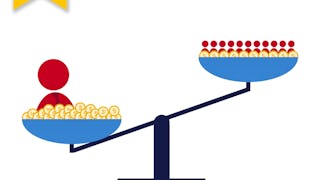This course is aimed at anyone who has interest in the lens through which mathematicians view democracy. You will learn theories and approaches to the mathematics of voting.



Recommended experience
Recommended experience
What you'll learn
Mathematics of voting
Theories of democracy
Skills you'll gain
Details to know
4 assignments
See how employees at top companies are mastering in-demand skills

There are 4 modules in this course
This module sets the stage for the entire Teach Out. We begin by discussing the nature of mathematics (as opposed to arithmetic) and develop a workable abstract model for democracy: a function that takes individual preferences and returns a group decision. We then look closely at different methods for two-party elections, fairness criteria we want these functions to have, and conclude that only the Simple Majority method satisfies those criteria.
What's included
6 videos1 reading1 assignment2 discussion prompts
This module builds on the work from Module 1 by considering elections with three (or more) candidates. We examine various decision functions (such as Plurality and Borda Counts) as well as properties we want those functions to have. We conclude with Arrow’s Theorem that shows that there are no decision functions satisfying basic fairness criteria.
What's included
7 videos1 reading1 assignment2 discussion prompts
In the previous modules we assumed that each voter ranks the candidates from most to least desirable; these individual rankings are the inputs to the decision functions. In this module we question the viability of asking voters to rank both for psychological reasons (it is very difficult to rank a long list of options) and—more to the point of this Teach Out—for mathematical reasons. We model preference using a simple game played with dice that illustrates non-transitive preference: A is better than B, B is better than C, but C is better than A!
What's included
3 videos1 reading1 assignment1 discussion prompt
This module considers mathematical issues arising in representative democracy in which elected officials make decisions for the larger population. In the United States House of Representatives, the number of representatives from a given state is proportional to the population of that state. However, since the number of representatives from a state must be a whole number, and the total number of representatives is 435, we need a method by which seats are allocated to states. We present the apportionment methods of Hamilton and Jefferson, and discuss problems arising with these methods. We conclude with a theorem of Balinsky and Young that shows there are no apportionment methods satisfying basic fairness conditions.
What's included
7 videos3 readings1 assignment1 discussion prompt
Instructor

Offered by
Explore more from Math and Logic


Johns Hopkins University


Utrecht University


Johns Hopkins University


Duke University
Why people choose Coursera for their career





Open new doors with Coursera Plus
Unlimited access to 10,000+ world-class courses, hands-on projects, and job-ready certificate programs - all included in your subscription
Advance your career with an online degree
Earn a degree from world-class universities - 100% online
Join over 3,400 global companies that choose Coursera for Business
Upskill your employees to excel in the digital economy
Frequently asked questions
Access to lectures and assignments depends on your type of enrollment. If you take a course in audit mode, you will be able to see most course materials for free. To access graded assignments and to earn a Certificate, you will need to purchase the Certificate experience, during or after your audit. If you don't see the audit option:
The course may not offer an audit option. You can try a Free Trial instead, or apply for Financial Aid.
The course may offer 'Full Course, No Certificate' instead. This option lets you see all course materials, submit required assessments, and get a final grade. This also means that you will not be able to purchase a Certificate experience.

